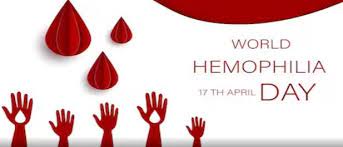World Hemophilia Day 2023 observed on 17th April

World Hemophilia Day 2023: Every year on April 17th, World Haemophilia Day commemorates the birth anniversary of Frank Schnabel, who founded the World Federation of Haemophilia. The purpose of this day is to raise awareness and provide information about hemophilia and other bleeding disorders. Haemophilia is a rare medical disorder in which the blood fails to clot properly due to a lack of particular clotting factors. This causes prolonged bleeding, which can be dangerous and life-threatening in some cases.
April 2023 Current Affairs Quiz
World Hemophilia Day 2023: Theme
“Access for All: Partnership, Policy, Progress – Engaging Governments to Integrate Inherited Bleeding Disorders into National Policy” is the subject for World Haemophilia Day in 2023. This theme highlights the importance of partnership and collaboration between various stakeholders, including governments, in ensuring access to appropriate care and treatment for individuals with hemophilia and other inherited bleeding disorders. The subject also emphasises the importance of incorporating these disorders into national policy in order to better diagnosis, treatment, and management of these disorders.
World Hemophilia Day: History
World Hemophilia Day is annually observed on April 17 to honor the founder of the World Federation of Hemophilia, Frank Schnabel, on his birthday. The World Federation encourages people around the globe to illuminate in red as a symbol of solidarity with those affected by hemophilia. In 1989, the purpose of World Haemophilia Day was to push for better diagnosis and access to care for people with haemophilia. This event aims to raise awareness about haemophilia and other blood-related disorders among individuals and carers.
What is Hemophilia?
Hemophilia is an uncommon medical condition where the blood is incapable of clotting correctly because of a shortage of specific clotting factors. This leads to prolonged bleeding, which can pose a life-threatening risk in some cases. Although there is no known cure for this disorder, available treatments can help control and manage the condition.
What causes Hemophilia?
Whenever an individual experiences bleeding from either an internal or external wound, the body initiates a response by collecting blood cells to create a clot, thereby stopping the bleeding. The process of clotting involves the interaction of blood proteins with platelet-like cells. Haemophilia can arise when a clotting factor is deficient. Haemophilia can be present from birth (congenital) or emerge later in life (acquired).
Symptoms
The primary symptom of hemophilia is abnormal or excessive bleeding or bruising, although the presentation of symptoms can vary among individuals with the condition. As per the National Organization for Rare Disorders (NORD), indications and signs of hemophilia may include:
- Bleeding from the mouth and gums
- Frequent nose bleeds
- Bleeding into the joints
- Bleeding after a circumcision
- Bloody stool
- Blood in urine
- Bleeding after vaccinations or other injections